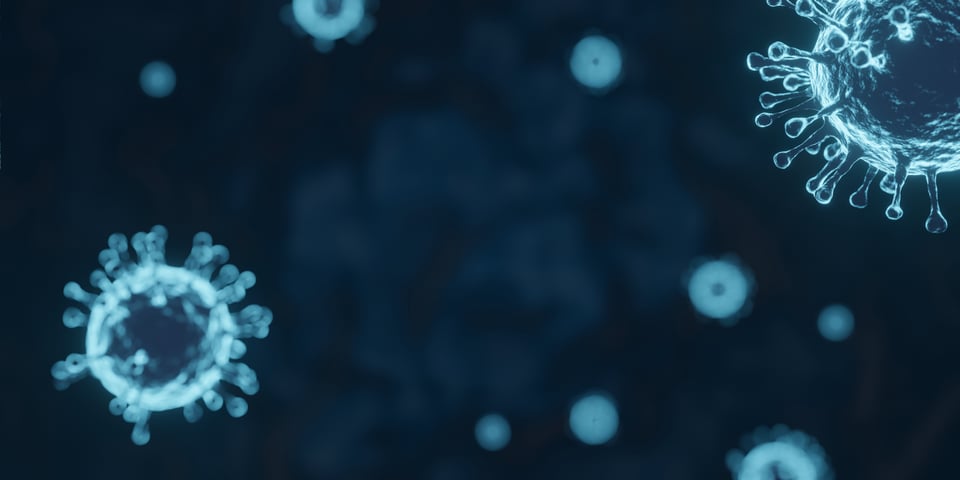
Even though scientific evidence suggests that surfaces are not the main transmission pathway of SARS-CoV-2, it cannot be ruled out that humans can be infected when interacting with virus-contaminated surfaces. The coronavirus has been shown to survive from minutes to days on several different materials, and it is therefore important to learn more about the surface adsorption and how different surface features affect the virus adsorption process.
Curious to learn more about how QSense QCM-D is used in such adsorption analysis, I reached out to Prof. Boaz Pokroy, Professor and Faculty member at Technion Israel Institute of Technology. Prof. Pokroy’s research focus is on Biomineralization and bio-inspired materials, and in a recent study,1 they characterized and compared the adsorption of SARS CoV-2 spike proteins on various functionalized surfaces. In this post, I share what I learned from the interview with Prof. Pokroy.
In my research group, we study various mineralized materials and soft materials in nature and correlate their structure on various length scales to their function, Prof. Pokroy says. We identify various strategies used in nature to form functional materials and translate these strategies to form new synthetic bio-inspired materials.
Studying the interaction of spike protein with surfaces is an essential stage in understanding the adsorption process of the whole virus to the surfaces, Prof. Pokroy explains. The spike protein is exposed to the surroundings and conducts the first interactions. These interactions can be with fomites or biological tissues such as mucosal tissue and the specific interactions with the ACE2 receptor, i.e., the receptor located on the host cells in our body.
The spike protein is composed of two subunits – S1 and S2. In this research, we studied the interactions of S1 and S2 subunits, from SARS-CoV-2 spike protein, with various chemically functionalized surfaces, Prof. Pokroy says. We compared the interactions between the original strain of SARS-CoV-2 to the Delta and Omicron variants and at different pH conditions. This way, we can study the effect of the mutations in Delta and Omicron variants on their adsorption capacities.
In this study, we used QCM-D to measure the difference in adsorption capacities of S1 and S2 subunits, Prof. Pokroy says. By applying the Sauerbrey equation or Voigt modeling, it was possible to calculate the mass density and thickness of the adsorbed protein layer.
In our experiments, we used five different surface functionalities to study the possible interactions of the protein subunit with each functionality type. The different functionalities were created using gold-coated sensors where the chemical properties of the sensor's surface were changed by using Self-Assembled Monolayers, so-called SAMs. SAMs are molecules that can self-arrange as one molecule thick homogenous layer. The functional group of the SAM can dictate the chemical properties of the surface.
In brief, the experiments were executed as follows:
In the second part of the study, we analyzed the influence of pH on protein adsorption, Prof. Pokroy continues. In this measurement series, we changed the pH of the PBS and the protein solution. We experimented in the same way, using only the SAM that showed the highest adsorption capacities in the previous step, i.e., the SAM with the carboxylic end-group.
Our study revealed that the different S1 subunits behave differently in the adsorption process, Prof. Pokroy says. The S1 subunit from Delta and Omicron variants showed higher adsorption, especially to the SAM with a carboxylic acid functional group where the surface is negatively charged. The positive surface charge of S1 protein in the variants is enhanced. The surface charge of the ACE2 receptor is mainly negative, as is the mucosal tissue. This means that the electrostatic interactions between the receptor/mucus and spike protein are increased, which correlates with the increased transmissibility of the variants, Prof. Pokroy explains. Moreover, S1 from the Omicron variant showed, on average, the highest adsorption to all surfaces, which might corroborate its highest transmissibility and infectivity among the variants.
The S2 subunit adsorbed best to SAM with a hydrophobic end-group, which can be explained by S2 transmembrane location. Most probably, the S2 subunit does not contribute to the overall interactions of whole spike proteins with the surrounding, Prof. Pokroy says.
Additionally, the S1 subunit demonstrated the highest adsorption capacity at pH 7.4, which is the physiological pH. Both acidic and basic environments significantly decrease the adsorption rates.
Using QCM-D, we could calculate the mass density of the spike protein subunits adsorbed layer and compare the influence of various modified surfaces, Prof. Pokroy says. These results aid in better understanding why and what affects the increased transmissibility of SARS-CoV-2 variants. It also shows the ability of the virus to bind to various surfaces which, can be relevant to the study of other viruses as well, he concludes.
Learn best practices and step-by-step methods for accurate QCM-D coating thickness measurement on QSense sensors using QSense Omni.
Compared to QCM, QCM-D measures an additional parameter, and provides more information about the system under study.
Discover how QCM-D analysis reveals real-time etching dynamics, helping optimize cleaning processes and protect surfaces from unwanted damage.
Discover how QSense QCM-D helps tackle fouling challenges across industries
Discover how QCM-D enables real-time, label-free analysis of supported lipid membrane formation, structure, and dynamics for advanced research
Learn how QSense QCM-D analysis can reveal membrane fouling dynamics and optimize cleaning strategies for more efficient water treatment
Learn how QSense QCM-D helps detect and prevent surface-induced instabilities in biologics. Join our webinar for insights and practical examples.
Learn about the top QSense sensors for analyzing biopharmaceutical drug-surface interactions in the context of IV bags.
Learn about QCM-D, Quartz Crystal Microbalance with Dissipation monitoring - an analytical tool for surface interaction studies at the nanoscale.
